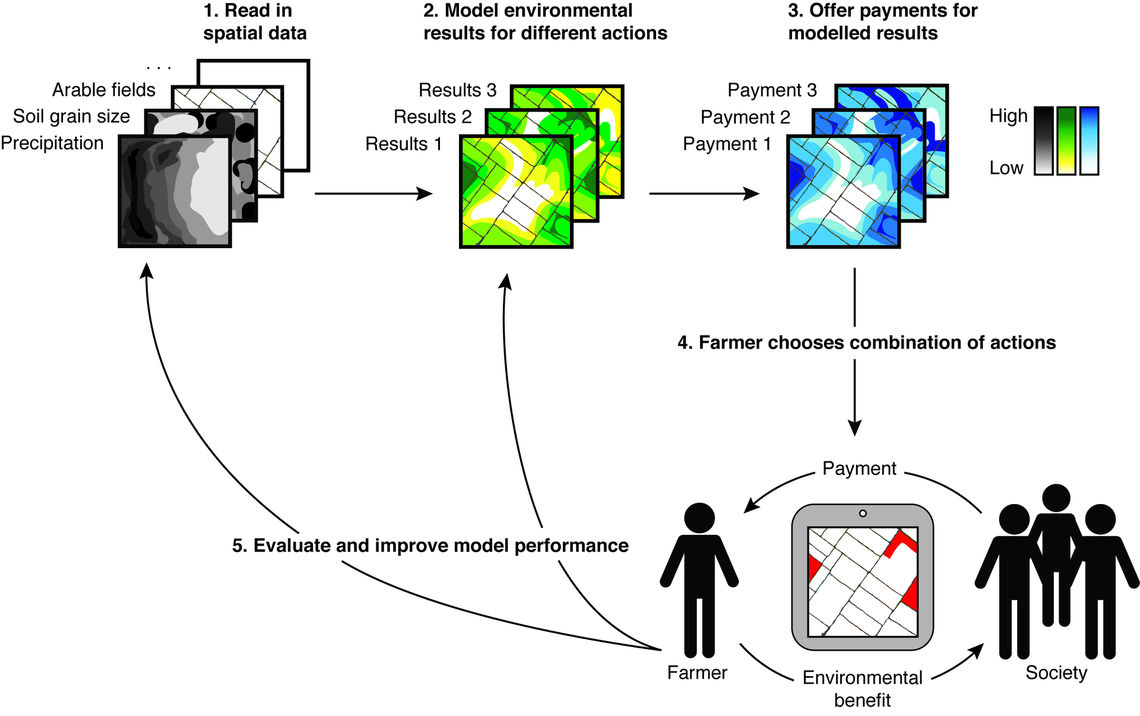PAMR: payments by modelled results
Incentive payments are the most widely used instrument of agri-environmental policy, including the agri-environment and climate measures of the EU Common Agricultural Policy. However, few agri-environmental payment schemes address soil management directly (Bartkowski et al. 2021a); furthermore, the spatial heterogeneity of soils makes it difficult to design effective schemes.
From a theoretical point of view, result-based agri-environmental payments are clearly preferable to action-based payments. While the latter are offered simply for the implementation of specified management practices, the former are based on measurements of changes in environmental good provision ("results"; e.g. soil functions) (Jeffery and Verheijen 2020). However, result-based payments suffer from two major practical disadvantages: costs of measuring the results and payment uncertainty for the participating farmers.
Building upon the soil function modelling advances in BonaRes, it is possible to suggest a third, hybrid design option for agri-environmental payments, which overcomes these two disadvantages by means of modelling (instead of measuring) the results. The concept of is called agri-environmental payments by modelled results (PAMR) (Bartkowski et al. 2021b). A schematic overview can be found in the Figure below.
pamr jpeg

The core idea is that, instead of using ex-post indicator measurements to determine the achievement of results, a PAMR scheme would employ models to predict the results. These predicted environmental effects would then be the basis for determining payments. In Step 1, models need to be fed with spatially explicit data describing agronomic, ecological and biophysical features of a farm’s land, e.g. landscape structure, field size, soil type, hydrology and crop rotation, that are needed to predict the effects of management on environmental outcomes. In Step 2, the farmer can choose from the menu of potential management actions, e.g. reduced tillage, reduced application of fertilizer, introduction of linear natural elements, and the model (e.g. Bodium) predicts environmental results, e.g. changes in the provision of soil functions, for a chosen combination and spatially explicit allocation of actions. In Step 3, payment offers are calculated for each combination of management actions, based on their modelled environmental results. In Step 4, the farmers can choose the alternative (combination of management actions) that best satisfies their own preferences and knowledge about their fields, e.g. soil productivity, cost structures, profitability, and other types of motivation. This step can be facilitated with a software application that provides a graphical user interface. In Step 5, the scheme is (if necessary) updated to improve the accuracy of predicted results and effectiveness in terms of environmental outcomes.
- Bartkowski, B., Bartke, S., Hagemann, N., Hansjürgens, B., Schröter-Schlaack, C., 2021a. Application of the governance disruptions framework to German agricultural soil policy. SOIL 7, 495–509. doi:10.5194/soil-7-495-2021
- Bartkowski, B., Droste, N., Ließ, M., Sidemo-Holm, W., Weller, U., Brady, M.V., 2021b. Payments by modelled results: a novel design for agri-environmental schemes. Land Use Policy 102:105230. doi:10.1016/j.landusepol.2020.105230 [ArXiv preprint]
- Jeffery, S., Verheijen, F.G.A., 2020. A new soil health policy paradigm: Pay for practice not performance! Environmental Science & Policy 112, 371–373. doi:10.1016/j.envsci.2020.07.006

